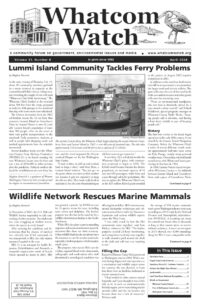Editor’s Note: Whatcom Watch has entered a cooperative agreement with Salish Current. When possible, we will share each other’s content. Salish Current, an online-only news organization, covers the North Sound area and Whatcom Watch mainly covers Whatcom County issues.
Community Voices
The essays, analyses and opinions presented as Community Voices express the perspectives of their authors on topics of interest and importance to the community, and are not intended to reflect perspectives on behalf of the Salish Current.
by Ginny Broadhurst
The Vancouver Fraser Port Authority has proposed that Roberts Bank Terminal 2 (RBT2) — a mega project consisting of a new three-berth marine container shipping terminal adjacent to an existing coal terminal — be constructed in Delta, British Columbia.
The building site is about 1 kilometer north of the international border between the United States and Canada, a location well known for its ecological value that lies between a variety of protected conservation areas for shorebirds and other wildlife.
The Salish Sea Institute (1)hosted a webinar about the project (2) last month attended by more than 150 people, with the majority (77 percent) from Washington and the rest from British Columbia.
Speakers included Ginny Broadhurst, Salish Sea Institute; Derek Moscato, Journalism Department at Western Washington University (WWU); and Natalie Baloy, Anthropology Department at WWU.
The presentations illustrated the challenges of managing an international ecosystem with governments that are accustomed to analyzing projects from a nationalistic perspective and review only the concerns that would occur within their own jurisdictional boundaries.
An extensive environmental review by a Canadian federal review panel clearly illustrates that it will have significant and permanent environmental impacts that include:
• loss of habitat for migrating endangered Chinook salmon and other species such as migratory shorebirds
• loss of critical habitat and loss of prey for endangered southern resident killer whales
• increased underwater noise in an already noisy ecosystem.
These impacts and others are documented in the Environmental Assessment (3) conducted by the Federal Panel. The panel also stated that the many proposed mitigation measures would not go far enough.
Legal challenges to the RBT2 project were announced soon after the Canadian federal government announced its approval in April 2023. Several nongovernmental environmental organizations in British Columbia are challenging (4) the project and are concerned that the government is failing to enforce its own Species at Risk Act.
The Lummi Nation has also challenged (5) the proposal, saying they weren’t adequately consulted.
For this proposal, evaluating impacts that would occur only in Canadian waters equates to a fictional geography using political boundaries rather than ecological or scientifically defensible boundaries for the areas affected. This results in an incomplete assessment. For projects that are so close to the border, and particularly for projects of this magnitude, agencies in Canada and the United States could and should consider the environmental impacts using a scientifically defensible, ecological approach.
The Salish Sea is already compromised by the cumulative effects of global climate change, regional urbanization and a growing population, as well as intensive human use and abuse across the ecosystem over the last two centuries, according to the “State of the Salish Sea” (6)report published by the institute in 2021.
What’s needed now is increased restoration and protective measures on both sides of the border. Projects that ignore cumulative impacts to threatened and endangered species put the system at further risk.
Here are some of the questions that arose during the webinar presentations:
Are Chinook salmon and southern resident killer whales listed as endangered in Canada as they are in the United States?
A. Yes, both species are listed in the federal Species at Risk Act which is similar but not identical to the U.S. Endangered Species Act.
How much fill is predicted to be part of the construction of the terminal?
A. Construction involves filling 437 acres of intertidal area in a highly valuable ecological area.
Is the permitting process complete for the RBT2 project?
A. Yes, the federal government of Canada and the Province of British Columbia have approved the project.
What’s next; when might construction start?
A. There are legal challenges to the project from environmental organizations in British Columbia and also from the Lummi Nation. It’s not clear whether those legal challenges will delay construction or not.
Did Gov. Jay Inslee’s office oppose the project?
A. Many environmental organizations in Washington requested opposition from Gov. Inslee in 2020. There was no stated public opposition from the governor’s office.
Why don’t agencies consider impacts across the international border?
A. Agencies are generally not required to consider impacts beyond their jurisdictional boundaries. But they can (and should) be encouraged to do so.
How much will RBT2 add to vessel traffic in the Strait of Juan de Fuca?
A. It’s expected that there will be 520 additional vessel trips annually. It’s also worth mentioning that RBT2 would have capacity for significantly larger vessels which would carry larger amounts of fuel.
For more information, see salish-current.org. https://salish-current.org/2023/11/08/bc-mega-container-terminal-questions-answered/
__________________________-
Endnotes
2. https://vimeo.com/873784095
3. https://iaac-aeic.gc.ca/050/documents/p80054/134506E.pdf
4. https://globalnews.ca/news/9718120/legal-challenge-robert-banks-terminal-bc/
6. https://cedar.wwu.edu/salish_pubs/1/
______________________
Ginny Broadhurst is the director of the Salish Sea Institute at Western Washington University.





























